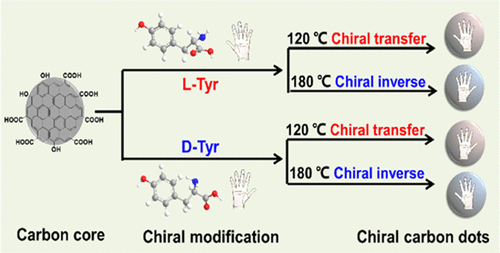当前位置:
X-MOL 学术
›
ACS Appl. Mater. Interfaces
›
论文详情
Our official English website, www.x-mol.net, welcomes your
feedback! (Note: you will need to create a separate account there.)
Chiral Control of Carbon Dots via Surface Modification for Tuning the Enzymatic Activity of Glucose Oxidase
ACS Applied Materials & Interfaces ( IF 8.3 ) Pub Date : 2021-01-22 , DOI: 10.1021/acsami.0c21949 Mengling Zhang 1 , Yurong Ma 1 , Huibo Wang 1 , Bo Wang 1 , Yunjie Zhou 1 , Yang Liu 1 , Mingwang Shao 1 , Hui Huang 1 , Fang Lu 2 , Zhenhui Kang 1, 3
ACS Applied Materials & Interfaces ( IF 8.3 ) Pub Date : 2021-01-22 , DOI: 10.1021/acsami.0c21949 Mengling Zhang 1 , Yurong Ma 1 , Huibo Wang 1 , Bo Wang 1 , Yunjie Zhou 1 , Yang Liu 1 , Mingwang Shao 1 , Hui Huang 1 , Fang Lu 2 , Zhenhui Kang 1, 3
Affiliation

|
Chiral carbon dots (CDs) integrated the advantages of achiral CDs and the unique chiral property, which expand the prospect of the biological applications of CDs. However, the structure control and the origin of chirality for chiral CDs remain unclear. Herein, chiral CDs were obtained by thermal polymerization of chiral amino acids and citric acid, and their handedness of chirality could be controlled by adjusting the reaction temperature, which leads to different kinds of surface modifications. With aliphatic amino acids as a chiral source, all of the CDs that reacted at different temperatures (90–200 °C) have the same handedness of the chiral source. But with aromatic amino acids as a chiral source, CDs with maintained or inversed handedness compared with the chiral source could be obtained by adjusting the reaction temperature. Below a temperature of 120 °C, the chiral source was modified with CDs by esterification and transferred the handedness of chirality; at high temperatures (above 150 °C), which mainly connected by amidation accompanying with the formation of rigid structure generated by the π conjugation between the aromatic nucleus of chiral source and the carbon core of CDs, caused the inversing of the chiral signal. Further, we investigated the chiral effects of CDs on the glucose oxidase activity for a highly sensitive electrochemical biosensor.
中文翻译:

通过表面修饰手性控制碳点,以调节葡萄糖氧化酶的酶活性
手性碳点(CD)融合了非手性CD的优点和独特的手性,从而扩大了CD生物学应用的前景。但是,手性CD的结构控制和手性的起源仍不清楚。在此,通过手性氨基酸和柠檬酸的热聚合获得手性CD,通过调节反应温度可以控制手性的手性,从而导致不同类型的表面改性。使用脂族氨基酸作为手性来源,所有在不同温度(90–200°C)下反应的CD都具有与手性来源相同的手性。但是,以芳香族氨基酸为手性来源,可以通过调节反应温度来获得与手性来源相比保持不变或反手性的CD。温度低于120°C时,手性源通过CD进行酯化改性,并转移了手性。在高温(高于150°C)下,手性信号的倒置主要是通过酰胺化连接而形成的刚性结构,而刚性结构是由手性源的芳香核与CD的碳核之间的π共轭产生的。此外,我们调查了CD的手性效应对高灵敏度电化学生物传感器的葡萄糖氧化酶活性的影响。手性信号的反转主要是通过酰胺化连接而形成的刚性结构,而刚性结构是由手性源的芳香核与CD的碳核之间的π共轭产生的。此外,我们调查了CD的手性效应对高灵敏度电化学生物传感器的葡萄糖氧化酶活性的影响。手性信号的反转主要是通过酰胺化连接而形成的刚性结构,而刚性结构是由手性源的芳香核与CD的碳核之间的π共轭产生的。此外,我们调查了CD的手性效应对高灵敏度电化学生物传感器的葡萄糖氧化酶活性的影响。
更新日期:2021-02-03
中文翻译:

通过表面修饰手性控制碳点,以调节葡萄糖氧化酶的酶活性
手性碳点(CD)融合了非手性CD的优点和独特的手性,从而扩大了CD生物学应用的前景。但是,手性CD的结构控制和手性的起源仍不清楚。在此,通过手性氨基酸和柠檬酸的热聚合获得手性CD,通过调节反应温度可以控制手性的手性,从而导致不同类型的表面改性。使用脂族氨基酸作为手性来源,所有在不同温度(90–200°C)下反应的CD都具有与手性来源相同的手性。但是,以芳香族氨基酸为手性来源,可以通过调节反应温度来获得与手性来源相比保持不变或反手性的CD。温度低于120°C时,手性源通过CD进行酯化改性,并转移了手性。在高温(高于150°C)下,手性信号的倒置主要是通过酰胺化连接而形成的刚性结构,而刚性结构是由手性源的芳香核与CD的碳核之间的π共轭产生的。此外,我们调查了CD的手性效应对高灵敏度电化学生物传感器的葡萄糖氧化酶活性的影响。手性信号的反转主要是通过酰胺化连接而形成的刚性结构,而刚性结构是由手性源的芳香核与CD的碳核之间的π共轭产生的。此外,我们调查了CD的手性效应对高灵敏度电化学生物传感器的葡萄糖氧化酶活性的影响。手性信号的反转主要是通过酰胺化连接而形成的刚性结构,而刚性结构是由手性源的芳香核与CD的碳核之间的π共轭产生的。此外,我们调查了CD的手性效应对高灵敏度电化学生物传感器的葡萄糖氧化酶活性的影响。











































 京公网安备 11010802027423号
京公网安备 11010802027423号